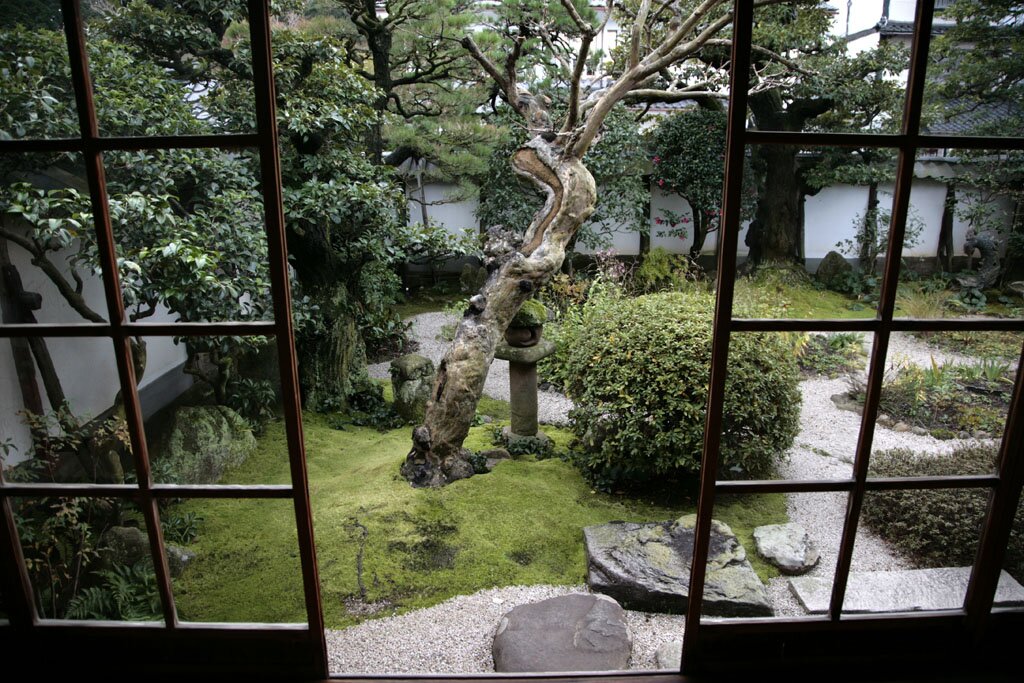The Fairytale Teller

We got off the train in Matsue and winter was waiting for us. Not the fun winter of snow, steamy breath on the still air and mass conviviality. No, this is not a Hollywood winter – this is the brutal winter of the real world, and it has not come to play. Instead, it brings a biting wind and a dull, threatening sky. There is little joy. You can see that on the empty streets, the only occasional inhabitants of which are unhappy, hooded souls trudging through the grey.
Clearly, this is not the Matsue that the Irish/Greek writer Lafcadio Hearn fell in love with, the town about which he wrote about with such verbose eloquence:
 “But oh, the charm of the vision – those first ghostly love-colours of a morning steeped in mist soft as sleep itself resolved into a visible exhalation! Long reaches of faintly-tinted vapour cloud the far lake verge – long nebulous bands, such as you may have seen in old Japanese picture-books… All the bases of the mountains are veiled by them, and they stretch athwart the loftier peaks at different heights like immeasurable lengths of gauze so that the lake appears incomparably larger than it really is, and not an actual lake, but a beautiful spectral sea of the same tint as the dawn-sky and mixing with it, while peak-tips rise like islands from the brume, and visionary strips of hill-ranges figure as league-long causeways stretching out of sight – an exquisite chaos, ever-changing aspect as the delicate fogs rise, slowly, very slowly. As the sun’s yellow rim comes into sight, fine thin lines of warmer tone – spectral violets and opalines – shoot across the flood, treetops take tender fire, and the unpainted faades of high edifices across the water change their wood-colour to vapoury gold through the delicious haze.”
“But oh, the charm of the vision – those first ghostly love-colours of a morning steeped in mist soft as sleep itself resolved into a visible exhalation! Long reaches of faintly-tinted vapour cloud the far lake verge – long nebulous bands, such as you may have seen in old Japanese picture-books… All the bases of the mountains are veiled by them, and they stretch athwart the loftier peaks at different heights like immeasurable lengths of gauze so that the lake appears incomparably larger than it really is, and not an actual lake, but a beautiful spectral sea of the same tint as the dawn-sky and mixing with it, while peak-tips rise like islands from the brume, and visionary strips of hill-ranges figure as league-long causeways stretching out of sight – an exquisite chaos, ever-changing aspect as the delicate fogs rise, slowly, very slowly. As the sun’s yellow rim comes into sight, fine thin lines of warmer tone – spectral violets and opalines – shoot across the flood, treetops take tender fire, and the unpainted faades of high edifices across the water change their wood-colour to vapoury gold through the delicious haze.”
Arriving in 1890, Hearn lived in this city in northern Shimane for more than 15 months, so there’s a good chance he endured days like today as well, but they rarely make for such poetry. Instead he focused on its seasonal beauty when writing long, lyrical essays for which he became famous in the west. Arriving as he did at the end of the 19th century, he was one of the first great writers to come to Japan and sing its praises, a kind of scholarly travel writer venturing where few of his contemporaries had ever been.
With the modern world Google-mapped to a point of utter tedium, such opportunities don’t really exist any more, but Hearn seized his with gusto. Because of Japan’s isolation policy, little had been written about rural Japan in the west, so Hearn was able to sculpt an image of the country with almost no contradiction.
He became famous in his adopted home too, mostly for his dazzling collection of folk and ghost stories. Kwaidan, published shortly before his death in 1904 was a seminal gathering of supernatural Japanese tales that the locals themselves had never been able to produce. Almost 60 years later, it was made into a wildly popular movie, which is part of the reason we’ve heard of Hearn’s name from Sendai to Kumamoto.
But it was in Matsue that he made his big start, and, despite looking a little like a strangled vulture, it was here that he found a wife. The daughter of a local samurai, Koizumi Setsu bore him four children. Today, one of his great-grandsons is the curator of the Lafcadio Hearn Memorial Museum, and his old residence, next door. Japan has changed immeasurably since the wandering scribe was alive, but on the edge of a moat facing a castle, it’s little wonder he chose to settle here – at least until itchy feet took him further around the country. Known as Koizumi Yakumo when he suddenly passed away at the age of just 54, Hearn may not have been truly Japanese, but he gave it a damn good try.
松江駅で私達を待ちうけていたのは、本格的な冬だった。それは雪降る中、白い息と楽しい雰囲気に包まれる、まるでハリウッド映画のような“冬”ではなく、鉛色の空に冷たい風が吹きつける容赦ない“冬”だ。人々は灰色の世界から逃げるように家路を急ぎ、通りには誰もいない。これはアイルランド人の父とギリシャ人の母を持つ作家、ラフカディオ・ハーンが“恋”し、多くの物語に登場する松江の姿ではないだろう。
1880年に来日したハーンは日本に移り住んで評価を得た最初の作家だったと言えるだろう。彼は旅行作家としても有名で、同世代の人がまだあまり足を運んだ事のない場所に行きそれを綴った。彼は島根の北部に15ヶ月以上住んでいたので、今日のようなどんよりとしたお天気の松江は何度も目にしているはずなのに、彼の残した詩はどれも美しく陽気に満ちている。彼は長編を書く際、四季の美しさにフォーカスするよりも、情熱的なエッセイを書き、西洋ではそのことで有名になった。
グーグル・マップなどがある今日ではニーズはないかもしれないが、当時は鎖国の影響もあって日本の、特に田舎の様子が西洋で語られる事は全くなかった。そこでハーンは日本についてのイメージをゼロから作りだしていったのだ。
彼は日本国内でも評価を得るようになり、特に日本の怪談話を集めた“怪談”は1904年、彼が亡くなる直前に出版された。そして約60年後、それは映画の原作となり、だからこそ私達は仙台や熊本など、各地でハーンの名前を耳にするのかもしれない。
彼が日本での生活をスタートさせたのはここ松江で、お世辞にもハンサムとは言えない彼はここで、武士の娘小泉セツと結婚をし4人の子供に恵まれた。今彼の曾孫は、彼が住んでいた自宅のとなりにあるラフカディオ・ハーン記念館の館長を務めている。今の日本は彼が生きていた頃とは劇的に変わっている。だが今日私とケイティはお堀に腰をおろしてお城を眺めながら、彼がここに住もうと思った気持が分かるような気がした。
小泉八雲は54歳でその生涯を閉じた。ハーンは完全に日本人にはなりきれていなかったかもしれない。だが彼が日本人として残してくれたものは大きい。





1 Comment
Joe Lafferty
December 10, 2011By here that Hearn can talk. Imagine trying to repeat that one sentence in one breath! His fellow Paddys would be proud of him!